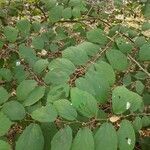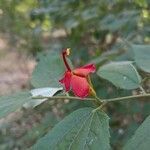| Therapeutic use
|
Parasympatholytics (aerial part), Fissure (bark), Abdominal pain (bark), Anemia (bark), Antioxidants (bark), Astringents (bark), Chest pain (bark), Common cold (bark), Cough (bark), Demulcents (bark), Diabetes mellitus (bark), Diarrhea (bark), Dysentery (bark), Dyspepsia (bark), Ear diseases (bark), Empyema (bark), Erectile dysfunction (bark), Expectorants (bark), Hyperlipidemias (bark), Inflammatory bowel diseases (bark), Intestinal diseases (bark), Intestinal diseases, parasitic (bark), Lactation (bark), Lipid peroxidation (bark), Paralysis (bark), Pharyngitis (bark), Respiratory tract diseases (bark), Scabies (bark), Snake bites (bark), Sprains and strains (bark), Stomach diseases (bark), Toothbrush (bark), Ulcer (bark), Vomiting (bark), Wounds and injuries (bark), Increased lactation (bark), Spondylosis (bark), Anemia (flower), Abdominal pain (fruit), Angiotensin-converting enzyme inhibitors (fruit), Anthelmintics (fruit), Anti-bacterial agents (fruit), Anti-inflammatory agents (fruit), Antiparasitic agents (fruit), Appetite stimulants (fruit), Asthma (fruit), Astringents (fruit), Avian myeloblastosis virus (fruit), Colic (fruit), Contraceptive agents (fruit), Cough (fruit), Demulcents (fruit), Diabetes mellitus (fruit), Diarrhea (fruit), Dysentery (fruit), Dyspepsia (fruit), Endophthalmitis (fruit), Epistaxis (fruit), Erectile dysfunction (fruit), Fever (fruit), Flatulence (fruit), Gastrointestinal diseases (fruit), Hemorrhage (fruit), Hemostasis (fruit), Hypnotics and sedatives (fruit), Inflammation (fruit), Inflammatory bowel diseases (fruit), Intestinal diseases (fruit), Intestinal diseases, parasitic (fruit), Lactation (fruit), Lipid peroxidation (fruit), Paralysis (fruit), Parasympatholytics (fruit), Respiratory tract diseases (fruit), Respiratory tract infections (fruit), Scabies (fruit), Skin diseases (fruit), Stomach diseases (fruit), Toothbrush (fruit), Ulcer (fruit), Vomiting (fruit), Wound healing (fruit), Wounds and injuries (fruit), Increased lactation (fruit), Spondylosis (fruit), Fissure (leaf), Abdominal pain (leaf), Anemia (leaf), Anthelmintics (leaf), Diabetes mellitus (leaf), Diarrhea (leaf), Dysentery (leaf), Earache (leaf), Eczema (leaf), Erectile dysfunction (leaf), Lactation (leaf), Malnutrition (leaf), Paralysis (leaf), Pruritus (leaf), Scabies (leaf), Skin diseases (leaf), Sprains and strains (leaf), Ulcer (leaf), Wounds and injuries (leaf), Spondylosis (leaf), Abdominal pain (root), Abortifacient agents (root), Analgesics (root), Anthelmintics (root), Anti-bacterial agents (root), Antifungal agents (root), Anti-inflammatory agents (root), Asthma (root), Astringents (root), Bites and stings (root), Carbuncle (root), Chest pain (root), Cholera (root), Colic (root), Cough (root), Demulcents (root), Diabetes mellitus (root), Diarrhea (root), Diuretics (root), Dysentery (root), Dysentery, amebic (root), Dyspepsia (root), Empyema (root), Expectorants (root), Fever (root), Flatulence (root), Furunculosis (root), Gastrointestinal diseases (root), Inflammatory bowel diseases (root), Intestinal diseases (root), Intestinal diseases, parasitic (root), Lactation disorders (root), Liver diseases (root), Neoplasms (root), Postnatal care (root), Rabies (root), Relaxation (root), Scabies (root), Snake bites (root), Stomach diseases (root), Vitiligo (root), Vomiting (root), Wounds and injuries (root), Increased lactation (root), Abdominal pain (seed), Hair loss (seed), Anti-bacterial agents (seed), Antirheumatic agents (seed), Astringents (seed), Breast diseases (seed), Bronchitis (seed), Colic (seed), Cough (seed), Demulcents (seed), Diabetes mellitus (seed), Diarrhea (seed), Dysentery (seed), Dyspepsia (seed), Epilepsy (seed), Expectorants (seed), Fever (seed), Flatulence (seed), Hemorrhage (seed), Inflammatory bowel diseases (seed), Intestinal diseases, parasitic (seed), Labor pain (seed), Malnutrition (seed), Muscular diseases (seed), Musculoskeletal diseases (seed), Pain (seed), Paralysis (seed), Poliovirus (seed), Pregnancy complications (seed), Scabies (seed), Snake bites (seed), Vomiting (seed), Increased lactation (seed), Otorrhea (seed), Cooling effect on body (seed), Anemia (stem), Dysentery (stem), Flatulence (stem), Pruritus (stem), Toothache (stem), Ache(Stomach) (unspecified), Antigalactogogue (unspecified), Aphrodisiac (unspecified), Appetizer (unspecified), Bilious (unspecified), Carbuncle (unspecified), Colic Diarrhea (unspecified), Colic (unspecified), Dysentery (unspecified), Empyema (unspecified), Intestine (unspecified), Sore (unspecified), Tumor (unspecified), Wound (unspecified), Parturition (unspecified), Amebiasis (unspecified), Cholera (unspecified), Demulcent (unspecified), Diarrhea (unspecified), Expectorant (unspecified), Stomach (unspecified), Tonic (unspecified), Astringent (unspecified), Abdominal pain (unspecified), Astringents (unspecified), Demulcents (unspecified), Intestinal diseases, parasitic (unspecified), Stomach diseases (unspecified), Wounds and injuries (unspecified)
|


